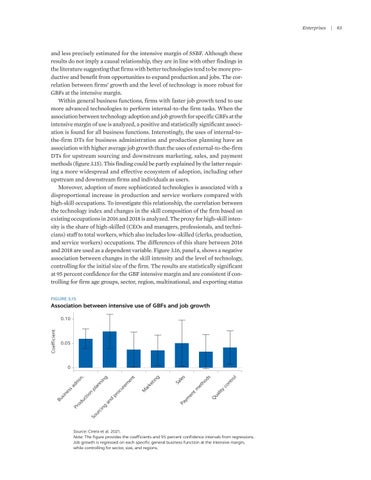Enterprises
and less precisely estimated for the intensive margin of SSBF. Although these results do not imply a causal relationship, they are in line with other findings in the literature suggesting that firms with better technologies tend to be more productive and benefit from opportunities to expand production and jobs. The correlation between firms’ growth and the level of technology is more robust for GBFs at the intensive margin. Within general business functions, firms with faster job growth tend to use more advanced technologies to perform internal-to-the firm tasks. When the association between technology adoption and job growth for specific GBFs at the intensive margin of use is analyzed, a positive and statistically significant association is found for all business functions. Interestingly, the uses of internal-tothe-firm DTs for business administration and production planning have an association with higher average job growth than the uses of external-to-the-firm DTs for upstream sourcing and downstream marketing, sales, and payment methods (figure 3.15). This finding could be partly explained by the latter requiring a more widespread and effective ecosystem of adoption, including other upstream and downstream firms and individuals as users. Moreover, adoption of more sophisticated technologies is associated with a disproportional increase in production and service workers compared with high-skill occupations. To investigate this relationship, the correlation between the technology index and changes in the skill composition of the firm based on existing occupations in 2016 and 2018 is analyzed. The proxy for high-skill intensity is the share of high-skilled (CEOs and managers, professionals, and technicians) staff to total workers, which also includes low-skilled (clerks, production, and service workers) occupations. The differences of this share between 2016 and 2018 are used as a dependent variable. Figure 3.16, panel a, shows a negative association between changes in the skill intensity and the level of technology, controlling for the initial size of the firm. The results are statistically significant at 95 percent confidence for the GBF intensive margin and are consistent if controlling for firm age groups, sector, region, multinational, and exporting status FIGURE 3.15
Association between intensive use of GBFs and job growth
Coefficient
0.10
0.05
co
nt
ro l
ho ds
s
ua lit Q
tm en
y
et
ke ar M
Pa ym
an d So
ur ci ng
Sa le
tin g
t en m oc ur e pr
tio uc Pr od
Bu
sin
n
es
s
pl
ad
an n
m
in g
in .
0
Source: Cirera et al. 2021. Note: The figure provides the coefficients and 95 percent confidence intervals from regressions. Job growth is regressed on each specific general business function at the intensive margin, while controlling for sector, size, and regions.
|
83



